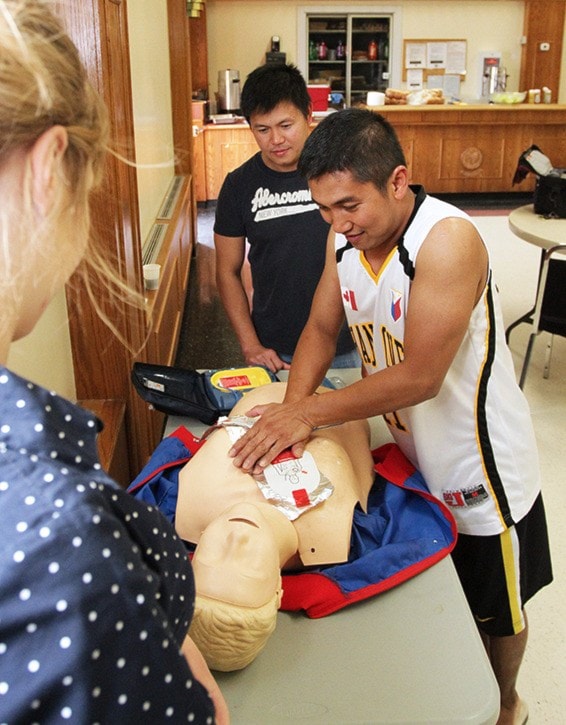In the time it takes for EMS crews to arrive at the scene of a cardiac arrest, an automated external defibrillator (AED) may be the one thing saving a person’s life.
The small box can be found in most public buildings in Ponoka and is usually found on a wall in an easy to see location. While it doesn’t look like much, an AED can save a person’s life, says Greg Sawisky, a third year medical student at the University of Alberta.
He and Alyson Kolk, also a third year medical student, showed attendees Tuesday, May 26 at the Kinsmen Community Centre how the small machines work and just how easy they are to use.
“It is basically a battery pack that can restart a person’s heart if their heart stops or if their heart goes into a very weird rhythm,” explained Sawisky.
Kolk’s hope is to give people a chance to become comfortable with AEDs. While they may never use one, being familiar with its functions is important. “Our biggest goal is that people will see one of these and be as comfortable with the AED as they are with a fire extinguisher,” she said.
These machines are designed for someone with no training or certification and both Sawisky and Kolk showed attendees just how it works. “They are dummy proof,” stated Sawisky.
Steps to using an AED
“With a heart attack typically what we look for is people complaining of crushing chest pains, sudden onset, sweating,” explained Sawisky on evaluating the need to use an AED.
A common phrase EMS or medical care personnel look for is patients complaining the pain is as if there is an elephant sitting on their chest. If an AED is needed, Sawisky recommends those who have to use it remain calm and follow the steps provided.
In the event that a person has cardiac arrest, bystanders can pull the AED off the wall, in some cases an alarm will sound, alerting EMS to attend, and unzip it.
Dummies and demonstration AEDs were used to show attendees the process, the only difference in these units, said Sawisky, is there was no electrical charge. In the package, there are three clear images that show each step needed to get the job done.
First: remove the person’s clothing to bare their chest, which allows the AED pads with electrodes to be in contact with the skin.
Sawisky says people should not worry of their initial assessment of a heart attack is wrong as AED electrodes detect the heart rhythm.
“If the person doesn’t need to be shocked, you cannot accidentally shock them,” he explained.
Second: apply the electrodes. A diagram shows the proper location to place the pads and a clear, calm voice explains how and where to place them. The voice guides a user through the entire process.
Third: Applying a shock. The AED then analyzes a patient’s heart rate and may recommend a shock. If so, those helping the patient will be asked to press a specific button that is clearly marked or blinking.
If further care is needed, the voice explains how to provide CPR or if a second shock is needed.
It takes minutes to complete the entire process and both Sawisky and Kolk suggests its application, while not something that occurs everyday, is an important life-saving tool that anyone can use.
Most AEDs come supplied with pads designed for youth or infants.
